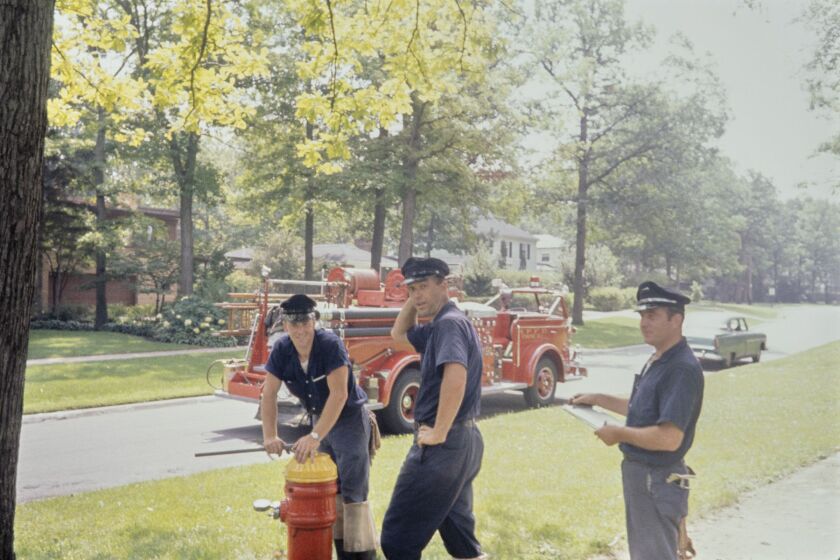Few artist profiles have skyrocketed more quickly than that of Vivian Maier, who went from an unknown at the time of her death in 2009 to one of this country’s most respected 20th-century street photographers.
The latest boost to her now-international reputation will come May 8 when the Chicago History Museum opens “Vivian Maier: In Color.” She is best known for her black-and-white photos, but this exhibition showcases 65 of the Chicagoan’s color images, the majority of which have not been shown before, and excerpts from some of her 8mm films.
“I think there is still a lot of character to this work,” said the museum’s guest curator Frances Dorenbaum, “but it has a slightly different tone, perhaps a little softer, a little subtler.”
The bulk of the show’s Chicago images are drawn from a group of nearly 1,800 color slides, negatives and transparencies from the 1950s-1970s that were donated to the museum in December 2020 by Chicago-based artist and art collector Jeffrey Goldstein.
“It’s a perfect for the History Museum in terms of something that might draw people into the building, get people thinking about Chicago and maybe even thinking about how they might capture the city if given the opportunity,” said John Russick, the museum’s senior vice president.
The gift became possible following the January 2020 resolution of a 5½-year court case between Goldstein, one of the three principal collectors who have owned and promulgated her work, and Maier’s estate, overseen by the state public administrator’s office for Cook County.
“I have a long family history with Chicago,” Goldstein said. “I have an affinity for museums, and I like John Russick. I love the idea of art reaching young people, and if I had to pick one word for Vivian Maier’s legacy, it’s inspiration.”
Maier (1926-2009), an American of French and Austro-Hungarian descent, learned photography while living in France in 1949 and pursued it avidly into the late 1990s, producing more than 100,000 images, many of them with a German-made, medium-format Rolleiflex camera.
In 1956, she moved to Highland Park to serve as a nanny for the Gensburg family, a job she held through the 1970s. During this time and her later work with other families, she devotedly took to the streets of Chicago, often capturing images of inauspicious, everyday people, and made other photos on trips in this country and abroad.
Some time around the turn of the century, she placed her camera equipment, photographs — many undeveloped — and other belongings in storage. These items were sold at auction in 2007 to cover past-due rent, and her hidden photographic legacy began to come light as several buyers began promulgating her work.
A selection of mostly black-and-white images were shown at the Chicago Cultural Center in early 2011, creating a sensation among both photography connoisseurs and the general public. “That was really the lightning-bolt moment,” Russick said.
She has gone on to be featured in more than 40 exhibitions worldwide, including “Vivian Maier’s Chicago” at the Chicago History Museum from 2012 through 2017, and showcased in a 2013 Academy Award-nominated documentary, “Finding Vivian Maier.”
In early 2010, Goldstein acquired a portion of Maier’s photographic holdings from one of the original buyers, Randy Prow, and added more later. (He has since sold all his black-and-white negatives.) “Vivian Maier: In Color” also includes loans from Ron Slattery and John Maloof.
The History Museum received a grant from the New York-based Gladys Krieble Delmas Foundation for the cataloging, preservation and online dissemination of the Maier holdings acquired from Goldstein.
All the prints on view from the museum collection are new digital scans from the original slides or transparencies. “For most of them,” Dorenbaum said, “prints didn’t exist. And for the ones that did, the length of the show is such that it would likely damage any original color prints if we kept them out the whole time.”
A major challenge was dealing with the inevitable degradation of color in the vintage images. The museum staff had to make decisions about how far to go in correcting and adjusting for these changes in the digital prints.
“We tried our best,” Dorenbaum said, “to do the most minimal adjustments to the digitized files so you could at least recognize the items or objects in the photograph as they might be presented in natural light. It was really tricky, for sure.”
Rather than dwell on Maier’s life, which has been investigated elsewhere, Dorenbaum chose to focus on the aesthetics of the images themselves. The show is organized thematically according to the photographer’s points of view – her different compositional or framing strategies. Its seven sections carry such titles as “Looking Up,” “Looking from Afar” and “Looking from Behind.”
In some cases, it is possible see how Maier used a similar approach to quite different subjects, as in a group of three photographs alternately depicting firefighters, flowers and a downtown Chicago landscape.
As excited as History Museum officials are about presenting parts of their new Maier holding for the first time, they are also hoping it might spur future donations of works by the photographer. “Growing this collection,” Russick said, “would be an appealing opportunity for us, absolutely.”
Kyle MacMillan is a Chicago freelance writer.








